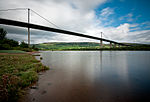Bowling railway station (Lanarkshire and Dunbartonshire Railway)
Disused railway stations in West DunbartonshireFormer Caledonian Railway stationsPages with no open date in Infobox stationRailway stations in Great Britain closed in 1917Railway stations in Great Britain closed in 1951 ... and 3 more
Railway stations in Great Britain opened in 1896Railway stations in Great Britain opened in 1919Scotland railway station stubs

Bowling railway station was a railway station located in the village of Bowling, Scotland, on the Lanarkshire and Dunbartonshire Railway. Bowling station was closed in 1951 before this section of the L&DR was abandoned in 1960 (the parallel GH&DR being retained and electrified as part of the North Clyde electrification scheme). The trackbed through Bowling now forms a footpath and cycleway, part of National Cycle Network Route 7.
Excerpt from the Wikipedia article Bowling railway station (Lanarkshire and Dunbartonshire Railway) (License: CC BY-SA 3.0, Authors, Images).Bowling railway station (Lanarkshire and Dunbartonshire Railway)
Scott Avenue,
Geographical coordinates (GPS) Address Nearby Places Show on map
Geographical coordinates (GPS)
| Latitude | Longitude |
|---|---|
| N 55.9321 ° | E -4.4892 ° |
Address
Scott Avenue 4
G60 5BA
Scotland, United Kingdom
Open on Google Maps








